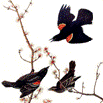Wildlife Damage Management, Internet Center for
Date of this Version
September 1968
Abstract
We are offering some remarks on what the entomologist would call the areas of cultural control. Our interest in this approach developed out of a series of information discussions we've had concerning regional planning pro-grams at Penn State. Our ideas on the applications of this to bird management are not well developed; we'd be happy to hear your suggestions and comments. The ideas of cultural control are not new and are only one of many approaches. But perhaps we are reaching a stage of public concern about bird problems and about environmental contamination which make the climate for long range plan-ning and cooperation more favorable. Most of the investigators and PCOs engaged in the management of bird populations are aware that the problem has two basic approaches: attacking the birds directly or making the environment unsuitable. Both these approaches are generally applied after the bird problem has developed. In the terminology of the medical profession, we are "treating symptoms." We build our cities, shopping centers, and airports and wait for the bird populations to develop. Then we use our ingenuity to attempt to remove the birds with poisons, repellents, or structural modifications, while at the same time, someone has to clean up the mess and mollify irritated citizens and customers. In this report, we shall suggest some of the ways of reducing bird problems at the design level—a method that can be considered ecological exclusion or preventive pest control.

